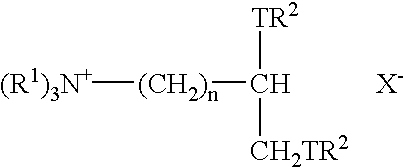Method of reducing the viscosity of fabric conditioning compositions
- Summary
- Abstract
- Description
- Claims
- Application Information
AI Technical Summary
Benefits of technology
Problems solved by technology
Method used
Image
Examples
example 1
[0128] Samples A to C, 1 and 2 were prepared at 200-ml scale. The fatty complexing agent and the ester-linked quaternary ammonium compound were heated together to between 50 and 60.degree. C. and stirred in order to provide a co-melt. The co-melt was then slowly added to water also at the same temperature while agitating. After 10 minutes of mixing, the batch was cooled using recirculating cold water. No shearing or milling was used during the process.
2TABLE 1 Component Sample Sample Sample Sample Sample (% by weight) A B 1 2 3 Tetranyl AHT- 13.0 13.0 13.0 13.0 13.0 1.sup.a Fatty 0 0.25 0.75 1.25 2.00 complexing agent.sup.b Water To 100 To 100 To 100 To 100 To 100 Total active 13 13.25 13.75 14.25 15 material (% by weight) Weight Ratio -- 8.84:1 2.93:1 1.76:1 1.10:1 of mono-ester component to fatty complexing agent .sup.adi-hardened tallowyl ester of triethanol ammonium methyl sulphate (available as 85% active softening material in 15% IPA, ex Kao) .sup.bTallow alcohol (available as...
example 2
[0133] Evaluation of the Fatty Complexing Agent on the Level of Mono-ester and Tri-ester Components
[0134] For samples A to B, and 1 to 3, the change in the DSC peak position and maximum peak height (mW) as a function of fatty alcohol concentration were measured.
[0135] The peak position and its intensity was measured using a Perkin Elmer DSC-7 having a heating / cooling cycle of from 0 to 85.degree. C. at 100.degree. C. per minute with the transitions being measured on the 2.sup.nd heating cycle.
[0136] The results are given in table 3.
4 TABLE 3 Peak 1 Amplitude Peak 2 Amplitude Sample (.degree. C.) (mW) (.degree. C.) (mW) Sample A 47 4.044 57 3.021 Sample B 47 3.406 57 3.150 Sample 1 46 2.439 59 3.400 Sample 2 45 1.747 63 4.409 Sample 3 45 1.050 65 5.636
[0137] The amplitude of peak 1 indicates the amount of mono-ester component present in the composition. The amplitude of peak 2 indicates the amount of tri-ester linked component (associated with some di-ester) present in the compositio...
PUM
 Login to View More
Login to View More Abstract
Description
Claims
Application Information
 Login to View More
Login to View More - R&D
- Intellectual Property
- Life Sciences
- Materials
- Tech Scout
- Unparalleled Data Quality
- Higher Quality Content
- 60% Fewer Hallucinations
Browse by: Latest US Patents, China's latest patents, Technical Efficacy Thesaurus, Application Domain, Technology Topic, Popular Technical Reports.
© 2025 PatSnap. All rights reserved.Legal|Privacy policy|Modern Slavery Act Transparency Statement|Sitemap|About US| Contact US: help@patsnap.com



